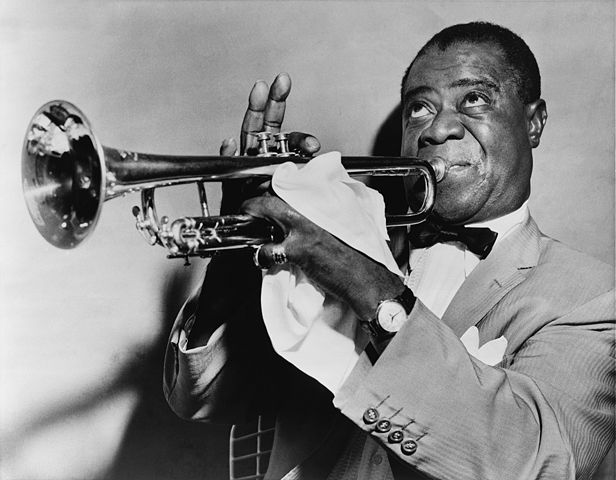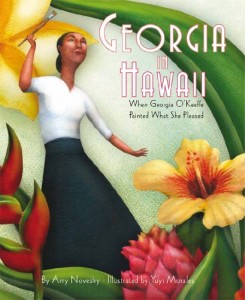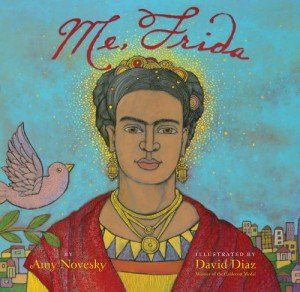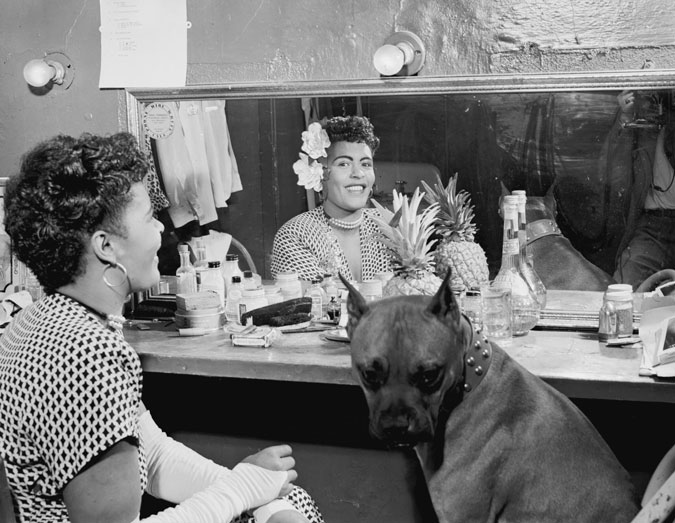new posts in all blogs
Viewing: Blog Posts Tagged with: Billie Holiday, Most Recent at Top [Help]
Results 1 - 8 of 8
How to use this Page
You are viewing the most recent posts tagged with the words: Billie Holiday in the JacketFlap blog reader. What is a tag? Think of a tag as a keyword or category label. Tags can both help you find posts on JacketFlap.com as well as provide an easy way for you to "remember" and classify posts for later recall. Try adding a tag yourself by clicking "Add a tag" below a post's header. Scroll down through the list of Recent Posts in the left column and click on a post title that sounds interesting. You can view all posts from a specific blog by clicking the Blog name in the right column, or you can click a 'More Posts from this Blog' link in any individual post.

By: VictoriaD,
on 6/30/2015
Blog:
OUPblog
(
Login to Add to MyJacketFlap)
JacketFlap tags:
*Featured,
harlem renaissance,
Online products,
Oxford African American Studies Center,
African American Studies Center,
African-American composers,
african-american music appreciation month,
black music,
black music month,
Music,
Barack Obama,
America,
Jimmy Carter,
Michael Jackson,
AASC,
billie holiday,
duke ellington,
Motown,
Timelines,
Add a tag
Celebrate the end of Black Music Month with this timeline highlighting over 100 years of music created and produced by influential African-Americans. Kenny Gamble, Ed Wright, and Dyana Williams developed the idea for Black Music Month back in 1979 as a way to annually show appreciate for black music icons. After lobbying, President Jimmy Carter hosted a reception to formally recognize the month.
The post 100 years of black music appeared first on OUPblog.

By: Ayana Young,
on 4/18/2015
Blog:
OUPblog
(
Login to Add to MyJacketFlap)
JacketFlap tags:
instrumentals,
Jass Appreciation Month,
Ragtime,
Music,
April,
Jazz,
Frank Sinatra,
blues,
Jam,
swing,
Louis Armstrong,
John Coltrane,
oxford music online,
billie holiday,
count basie,
duke ellington,
classical music,
herbie hancock,
Mary Lou Williams,
Dizzy Gillespie,
Bing Crosby,
Ella Fitzgerald,
bebop,
American National Biography,
soul music,
Benny Goodman,
*Featured,
Jazz Music,
Audio & Podcasts,
Chet Baker,
Nina Simone,
Online products,
Grove Music Online,
African American Studies Center,
Add a tag
Established in 2001, Jazz Appreciation Month celebrates the rich history, present accolades, and future growth of jazz music. Spanning the blues, ragtime, dixieland, bebop, swing, soul, and instrumentals, there's no surprise that jazz music has endured the test of time from its early origins amongst African-American slaves in the late 19th century to its growth today.
The post A Jazz Appreciation Month Playlist appeared first on OUPblog.

By: Alice,
on 7/24/2014
Blog:
OUPblog
(
Login to Add to MyJacketFlap)
JacketFlap tags:
Books,
Music,
bernstein,
billie holiday,
Leonard Bernstein,
*Featured,
Theatre & Dance,
Arts & Leisure,
stuff”,
Bernstein Meets Broadway,
Carol J. Oja,
Collaborative Art in a Time of War,
Add a tag
When Leonard Bernstein first arrived in New York, he was unknown, much like the artists he worked with at the time, who would also gain international recognition. Bernstein Meets Broadway: Collaborative Art in a Time of War looks at the early days of Bernstein’s career during World War II, and is centered around the debut in 1944 of the Broadway musical On the Town and the ballet Fancy Free. This excerpt from the book describes the opening night of Fancy Free.
When the curtain rose on the first production of Fancy Free, the audience at the old Metropolitan Opera House did not hear a pit orchestra, which would have followed a long-established norm in ballet. Rather, a recorded vocal blues wafted from the stage. Those attending must have been caught by surprise, as they were drawn into a contemporary sound world. The song was “Big Stuff,” with music and lyrics by Bernstein. It had been conceived with the African American jazz singer Billie Holiday in mind, even though it ended up being recorded for the production by Bernstein’s sister, Shirley. At that early point in Bernstein’s career, he lacked the cultural and fiscal capital to hire anyone as famous as Holiday. The melody and piano accompaniment for “Big Stuff” contained bent notes and lilting rhythms basic to urban blues, and the lyrics summoned up the blues as an animate force, following a standard rhetorical mode for the genre:
So you cry, “What’s it about, Baby?”
You ask why the blues had to go and pick you.
Talk of going “down to the shore” vaguely referred to the sailors of Fancy Free, as the lyrics became sexually explicit:
So you go down to the shore, kid stuff.
Don’t you know there’s honey in store for you, Big Stuff?
Let’s take a ride in my gravy train;
The door’s open wide,
Come in from out of the rain.
“Big Stuff” spoke to youth in the audience by alluding to contemporary popular culture. It boldly injected an African American commercial idiom into a predominantly white high-art performance sphere, and its raunchiness enhanced the sexual provocations of Fancy Free. “Big Stuff” also blurred distinctions between acoustic and recorded sound. It marked Bernstein as a crossover composer, with the talent to write a pop song and the temerity to unveil it within a high-art context.

Billie Holiday by William P. Gottlieb, c. February 1947. Public domain via Wikimedia Commons.
Billie Holiday was “one of [Bernstein’s] idols,” according to Humphrey Burton. He admired her brilliance as a performer, and he was also sympathetic to her progressive politics. In 1939, Holiday first recorded “Strange Fruit,” a song about a lynching that became one of her signatures. With biracial and left-leaning roots, “Strange Fruit” was written by the white teacher and social activist Abel Meeropol. Holiday performed “Strange Fruit” nightly at Café Society, a club that enforced a progressive desegregationist agenda both onstage and in the audience. Those performances marked “the beginning of the civil rights movement,” recalled the famed record producer Ahmet Ertegun (founder of Atlantic Records). Barney Josephson, who ran Café Society, famously declared, “I wanted a club where blacks and whites worked together behind the footlights and sat together out front.”
Bernstein had experience on both sides of Café Society’s footlights. In the early 1940s, he performed there occasionally with The Revuers, and he played excerpts from The Cradle Will Rock in at least one evening session with Marc Blitzstein. Bernstein also hung out at the club with friends, including Judy Tuvim, Betty Comden, and Adolph Green, listening to the jazz pianist Teddy Wilson and boogie-woogie pianists Pete Johnson and Albert Ammons. Thus Bernstein had ample opportunities to witness the intentional “blurring of cultural categories, genres, and ethnic groups” that historian David Stowe has called the “dominant theme” of Café Society.
Robbins also had an affinity for the work of Billie Holiday. In the summer of 1940, he choreographed Holiday’s recording of “Strange Fruit” and performed it with the dancer Anita Alvarez at Camp Tamiment. “Strange Fruit was one of the most dramatic and heart-breaking dances I have ever seen—a masterpiece,” remembered Dorothy Bird, a dancer there that summer.
As a result of these experiences, the music of Billie Holiday had crossed the paths of both Robbins and Bernstein before “Big Stuff” opened their first ballet. While Billie Holiday’s voice was not heard the evening of Fancy Free’s premiere, only seven months passed before she recorded “Big Stuff” with the Toots Camarata Orchestra on November 8, 1944. The fact that Holiday made this recording so soon after the premiere of Fancy Free bore witness to the rapid rise of Bernstein’s clout within the music industry. Over the next two years, Holiday made six more recordings of “Big Stuff,” and when Bernstein issued the first recording of Fancy Free with the Ballet Theatre Orchestra in 1946, Holiday’s rendition of “Big Stuff” opened the disc. Both she and Bernstein recorded for the Decca label. Holiday recorded her final three takes of “Big Stuff” for Decca on March 13, 1946, and that label released Fancy Free the same year.
Musically, “Big Stuff” links closely to the worlds of George Gershwin and Harold Arlen, whose songs drew on African American idioms. Like some of the most beloved songs by these composers — whether Arlen’s “Stormy Weather” of 1933 or Gershwin’s “Summertime” of 1935 from Porgy and Bess – “Big Stuff” used a standard thirty-two-bar song form. With a tempo indication of “slow & blue,” “Big Stuff” has a lilting one-bar riff in the bass, a classic formulation for a jazzbased popular song of the day. The riff retains its shape throughout, as is also typical, while its internal pitch structure shifts in relation to the harmonic motion. Both the accompaniment and melody are drenched with signifiers of the blues, especially with chromatically altered third, fourth, sixth, and seventh scale degrees, and the overall downward motion of the melody is also characteristic of the blues, with a weighted sense of being ultimately earthbound.
Carol J. Oja is William Powell Mason Professor of Music and American Studies at Harvard University. She is author of Bernstein Meets Broadway: Collaborative Art in a Time of War and Making Music Modern: New York in the 1920s (2000), winner of the Irving Lowens Book Award from the Society for American Music.
Subscribe to the OUPblog via email or RSS.
Subscribe to onyl music articles on the OUPblog via email or RSS.
The post Echoes of Billie Holiday in Fancy Free appeared first on OUPblog.


By: OwenK,
on 4/24/2014
Blog:
OUPblog
(
Login to Add to MyJacketFlap)
JacketFlap tags:
Music,
Jazz,
armstrong,
Louis Armstrong,
gmo,
grove,
oxford music online,
billie holiday,
what a wonderful world,
OMO,
*Featured,
hardin,
Audio & Podcasts,
Arts & Leisure,
Online products,
Grove Music Online,
heebie jeebies,
lil hardin armstrong,
muggles,
music playlist,
armstrong’s,
trumpeter,
Add a tag
April is Jazz Appreciation Month, honoring an original American art form. Across the United States and the world, jazz lovers are introducing people to the history and heritage of jazz as well as extraordinary contemporary acts. To celebrate, here are eight songs from renowned jazz singer and trumpeter Louis Armstrong‘s catalog, along with some lesser-known facts about the artist.
Heebie Jeebies (1926)
One of Armstrong’s first recordings as bandleader was a series of singles released under the name Louis Armstrong and his Hot Five, which were later regarded as a watershed moment in the history of jazz. “Heebie Jeebies” in particular gained fame, and historical importance, for its improvised “scat” chorus; according to legend, this off-the-cuff vocal part was the result of Armstrong dropping his sheet music during the recording.
Struttin’ With Some Barbecue (1927)
Armstrong’s second wife, Lil Hardin Armstrong, was instrumental in orchestrating his rise to prominence. Hardin was also an accomplished jazz pianist and composer, frequently collaborating with Armstrong; “Struttin’ With Some Barbecue” is one of her most-beloved contributions to the jazz canon.
Muggles (1928)
Long before J.K. Rowling transformed the word, “muggles” was a slang term for marijuana, a drug of which Armstrong was a lifelong enthusiast. This highly-esteemed composition by Armstrong was recorded with a group of the day’s foremost jazz talents, among them the legendary pianist Earl “Fatha” Hines.

Ain’t Misbehavin’ (1929)
Although Armstrong had achieved renown among black listeners through his work in the ‘20s, it was this song, performed between acts during the Broadway musical Hot Chocolates, which arguably gained him his first crossover success. Originally written as an excuse to have Armstrong sing from the orchestra pit, its success led the producers to rewrite the script in order to bring him onstage, then send him to the studio to record the production’s hits.
Where The Blues Were Born In New Orleans (1947)
The film New Orleans featured Armstrong alongside Billie Holiday, in her only film role; the pair portrayed musicians who develop a romantic relationship. This track includes a lengthy section in which Armstrong introduces his ensemble, featured in the film, which was loaded with the day’s biggest names: Kid Ory, Zutty Singleton, Bud Scott, and more.
Mack the Knife (1955)
In the later decades of his career, Armstrong’s lip muscles no longer allowed him to perform the same kind of trumpet pyrotechnics he’d become known for earlier in his career. As a result, he began to rely more on pop vocal performances, such as this, one of his best-known songs of all time. Taken from The Threepenny Opera, Bertolt Brecht and Kurt Weill’s anticapitalist stage drama, “Mack” became a major pop success (although it did not achieve the same recognition as the white singer Bobby Darin’s #1 version, released four years later).
Hello, Dolly (1964)
Probably the biggest hit of Armstrong’s career, this song, taken from the eponymous musical, took the #1 spot on the pop charts from the Beatles during the height of Beatlemania.
What a Wonderful World (1967)
Perhaps surprisingly, this song — perhaps the tune most closely associated with Armstrong — was not a hit in America upon its release, selling only about 1000 copies. Over time, owing to its frequent use in films and numerous cover versions, the song would eclipse all others in Armstrong’s discography to become his signature recording, but not until long after his death in 1971.
Grove Music Online has made several articles available freely to the public, including its lengthy entry on the renowned jazz singer and trumpeter Louis Armstrong. Oxford Music Online is the gateway offering users the ability to access and cross-search multiple music reference resources in one location. With Grove Music Online as its cornerstone, Oxford Music Online also contains The Oxford Companion to Music, The Oxford Dictionary of Music, and The Encyclopedia of Popular Music.
Subscribe to the OUPblog via email or RSS.
Subscribe to only music articles on the OUPblog via email or RSS.
Image credit: Louis Armstrong, jazz trumpeter, 1953. World-Telegram staff photographer. Library of Congress Prints and Photographs Division. Public domain via Wikimedia Commons.
The post An intriguing, utterly incomplete history of Louis Armstrong appeared first on OUPblog.


By: Maggie Belnap,
on 3/13/2014
Blog:
OUPblog
(
Login to Add to MyJacketFlap)
JacketFlap tags:
Online products,
Quizzes & Polls,
women musicians,
downbeat,
attachment_63022,
belnap,
maggie,
diagrams,
1946,
Music,
History,
Biography,
women's history month,
Oxford Reference,
big mama thornton,
*Featured,
billie,
Bessie Smith,
Arts & Leisure,
billie holiday,
complementing,
Add a tag
Women musicians are constantly pushing societal boundaries around the world, while hitting all the right notes. In honor of Women’s History Month, Oxford University Press is testing your knowledge about women musicians. Take the quiz and see if you’re a shower singer or an international composer!
Your Score:
Your Ranking:
Maggie Belnap is an intern in the Social Media Department at Oxford University Press. She is a student at Amherst College.
Oxford Reference is the home of reference publishing at Oxford. With over 16,000 photographs, maps, tables, diagrams and a quick and speedy search, Oxford Reference saves you time while enhancing and complementing your work.
Subscribe to OUPblog via email or RSS.
Subscribe to only music articles on the OUPblog via email or RSS.
The post Women of 20th century music appeared first on OUPblog.

By:
TCBR,
on 3/21/2012
Blog:
The Children's Book Review
(
Login to Add to MyJacketFlap)
JacketFlap tags:
Writing Resources,
Ages 4-8,
Ages 9-12,
Picture Books,
Yuyi Morales,
Author Interviews,
featured,
Books for Girls,
David Diaz,
Billie Holiday,
Women's History,
Lisa Congdon,
Amy Novesky,
Georgia O’Keeffe,
Cultural Wisdom,
Frida Kahalo,
Add a tag
By Nicki Richesin, The Children’s Book Review
Published: March 21, 2012

Amy Novesky
Amy Novesky is the author of Elephant Prince; Me, Frida and most recently Georgia in Hawaii. A former editor at Chronicle Books, Novesky brings years of experience to her work as both a children’s book editor and author. She teaches writing workshops to aspiring authors and is co-founder of Ever After Studio, a children’s book production company and the creative director of Paper Hat Press, a company that creates customizable children’s book and keepsakes. She discussed her research on Georgia O’Keeffe (in Hawaii) and Billie Holiday and Imogen Cunningham for her forthcoming books Mister and Lady Day and Imogen.
Nicki Richesin: Congratulations on the publication of Georgia in Hawaii! When I think of Georgia O’Keeffe, I tend to think of her hiking on Ghost Ranch. What inspired you to tell this story of her trip to Hawaii?
 Amy Novesky: I think most people think of Georgia that way, and there are some beautiful picture books that tell that story. But few people know that Georgia painted in Hawaii, and that’s exactly why I wrote this book. Imagine this painter famous for painting flowers and landscapes, painting in the most beautiful flower-filled landscape of all. I also wrote this book because I have a connection to Hawaii, and if there was any Georgia book I was going to write, it was this one.
Amy Novesky: I think most people think of Georgia that way, and there are some beautiful picture books that tell that story. But few people know that Georgia painted in Hawaii, and that’s exactly why I wrote this book. Imagine this painter famous for painting flowers and landscapes, painting in the most beautiful flower-filled landscape of all. I also wrote this book because I have a connection to Hawaii, and if there was any Georgia book I was going to write, it was this one.
NR: March is Women’s History Month and you have published wonderful books on truly remarkable women like Frida Kahlo and Georgia O’Keeffe and even more coming soon. What do you look for in a person’s life to make you want to tell his or her story and how do you find the hook that will appeal to a broad audience of readers?
 AN: Most stories start with the art. I am drawn to the art. Often, though, I’m drawn as much, if not more, to the artist. For example, I knew I wanted to write stories about both Frida Kahlo and Billie Holiday, but with each I didn’t want to tell the typical narrative. And then, too, especially with Frida and Billie, I had the added challenge of finding a story that was kid-friendly, given how tragic both of their lives were. (Frida had polio as a child and was in a horrific accident as a young adult; Billie was a child prostitute an
AN: Most stories start with the art. I am drawn to the art. Often, though, I’m drawn as much, if not more, to the artist. For example, I knew I wanted to write stories about both Frida Kahlo and Billie Holiday, but with each I didn’t want to tell the typical narrative. And then, too, especially with Frida and Billie, I had the added challenge of finding a story that was kid-friendly, given how tragic both of their lives were. (Frida had polio as a child and was in a horrific accident as a young adult; Billie was a child prostitute an

By: Maryann Yin,
on 11/16/2010
Blog:
Galley Cat (Mediabistro)
(
Login to Add to MyJacketFlap)
JacketFlap tags:
Children's Books,
Celebrities,
George W. Bush,
Random House,
Cesar Chavez,
Martin Luther King Jr.,
Barack Obama,
Helen Keller,
Loren Long,
George Washington,
Bill Clinton,
Jane Addams,
Maya Lin,
Abraham Lincoln,
Billie Holiday,
Jackie Robinson,
Albert Einstein,
Neil Armstrong,
eil Armstrong,
Georgia O’Keeffe,
Michelle Frey,
Robert B. Barnett,
Sitting Bull,
Add a tag
 President Barack Obama‘s picture book, Of Thee I Sing, arrived in bookstores and eBook format today. Random House has also released a promotional video about the book.
President Barack Obama‘s picture book, Of Thee I Sing, arrived in bookstores and eBook format today. Random House has also released a promotional video about the book.
Here’s more about the book, from the release: “Obama’s poignant words and Loren Long’s stunning images together capture the promise of childhood and the personalities and achievements of the following Americans: Georgia O’Keeffe, Albert Einstein, Jackie Robinson, Sitting Bull, Billie Holiday, Helen Keller, Maya Lin, Jane Addams, Dr. Martin Luther King Jr., Neil Armstrong, Cesar Chavez, Abraham Lincoln and George Washington.”
President Obama’s attorney, Robert B. Barnett, handled the negotiations for the manuscript back in 2009. Knopf executive editor Michelle Frey edited the book. Children’s book artist Loren Long provided the illustrations.
continued…
New Career Opportunities Daily: The best jobs in media.
Ever wonder how deep the ocean is?Well, listen to this poem–one of many that make up Carole Boston Weatherford’s biography of Billie Holiday in verse–and you may discover a new way of thinking about the ocean and its depth:How Deep is the Ocean?Without the microphone,there would be no spotlight,no band backing mewith bluesy swing.My voice was small,barely an octave,but the mic enlarged my songs,









 President
President